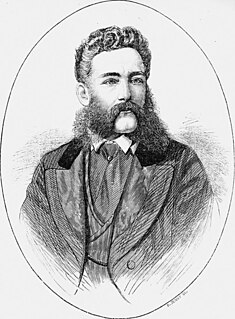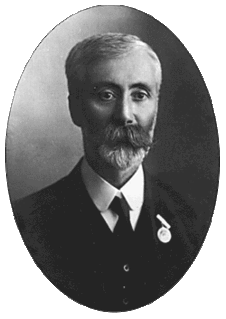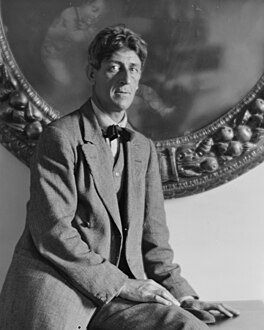
Deer Park is a suburb in Melbourne, Victoria, Australia, 17 km (11 mi) west of Melbourne's Central Business District, located within the City of Brimbank local government area. Deer Park recorded a population of 18,145 at the 2021 census.

Sunshine is a suburb in Melbourne, Victoria, Australia, 12 km (7.5 mi) west of Melbourne's Central Business District, located within the City of Brimbank local government area. Sunshine recorded a population of 9,445 at the 2021 census.

William Robert Guilfoyle was an English landscape gardener and botanist in Victoria, Australia, acknowledged as the architect of the Royal Botanic Gardens, Melbourne and was responsible for the design of many parks and gardens in Melbourne and regional Victoria.

Albion is a suburb in Melbourne, Victoria, Australia, 14 km (8.7 mi) west of Melbourne's Central Business District, located within the City of Brimbank local government area. Albion recorded a population of 4,334 at the 2021 census.

Joseph Henry Maiden was a botanist who made a major contribution to knowledge of the Australian flora, especially the genus Eucalyptus. This botanist is denoted by the author abbreviation Maiden when citing a botanical name.
John Stanley Beard was a British-born forester and ecologist who resided in Australia. Beard studied at the University of Oxford where he completed his doctoral thesis on tropical forestry.

Hugh Victor McKay was an Australian industrialist who is known for heading the company that developed the Sunshine Harvester, arguably the first commercially viable combine harvester. He subsequently established the Sunshine Harvester Works, which became one of Australia's largest manufacturers of agricultural equipment.

William Hardy Wilson was an Australian architect, artist and author. He "is regarded as one of the most outstanding architects of the twentieth century".
Dr Henry Norman Burgess Wettenhall AM (1915-2000) was an Australian paediatric endocrinologist, philanthropist, bibliophile and amateur ornithologist. Wettenhall was born in London while his family were living there before returning to Australia, where they lived in Toorak, Victoria. He was educated at Glamorgan, The Geelong College and the University of Melbourne, where he graduated from medicine in 1940.
John Carne Bidwill was an English botanist who documented plant life in New Zealand and Australia. He is attributed with the discovery of several Australian plant species.
Formed in 1980, the Australian Garden History Society (AGHS) is an Australian history society dedicated to the study of Australian garden history and the conservation of significant landscapes and historic gardens.
Thomas Ronald Garnett OAM was an English and Australian headmaster, horticulturist, ornithologist and author. Before the Second World War, he played first-class cricket for Somerset.
Thistle Yolette Harris, also known as Thistle Stead, was an Australian botanist, educator, author and conservationist.

Stony Creek is located in the western suburbs of Melbourne, Victoria, Australia. It runs through the suburbs of St Albans, Albion, Sunshine, Braybrook, Tottenham, Brooklyn, Kingsville and Yarraville.
Jean Galbraith was an Australian botanist, gardener, writer of children's books and poet.

Alister Clark (1864–1949) was the best known and most influential Australian rose breeder. His roses were the most widely planted in Australia between the World Wars and made an enduring difference to the appearance of Australian cities. His experiments hybridising Rosa gigantea were in world class and have never been surpassed.
Roger David Spencer is an Australia horticultural botanist who was born at Alfreton, Derbyshire. He has an honours degree in botany from the University College of Wales, Aberystwyth, a master's degree and doctorate from the University of Melbourne and a technical certificate in gardening and turf maintenance from Oakleigh Technical College, Melbourne. He is currently horticultural botanist at the Royal Botanic Gardens Melbourne where he works in the Plant Identification Service, contributing locally and internationally to the study of cultivated plant taxonomy.

The Sunshine Harvester works, was an Australian factory making agricultural equipment founded by industrialist H. V. McKay, and with engineering development headed by H.B. Garde.
Enoch Pearson Barratt was an Australian nursery proprietor who established one of the earliest commercial nurseries in Western Australia.

The Regional Rail Link (RRL) was a project to build a 47.5 kilometre length of railway through the western suburbs of Melbourne, Victoria, the main aim of which was to separate regional V/Line Ballarat, Bendigo and Geelong services from the electrified Melbourne suburban services, thereby increasing rail capacity and reliability. The project involved the building of an extra pair of tracks from Southern Cross station to Sunshine, parallel to the Western line, and a new double-track line from Deer Park, which joins with the Warrnambool line west of Werribee, near the site of the former Manor railway station. New stations were built at Tarneit and Wyndham Vale, while West Footscray and Sunshine stations were rebuilt. Additional platforms were built at Southern Cross and Footscray stations, and two level crossings near Sunshine were replaced by grade separations. The most used station before its construction, North Melbourne, was excluded from the project despite being the main connection hub for regional travellers not needing to go all the way to Southern Cross, and now requires regional rail link customers to change at Footscray.











